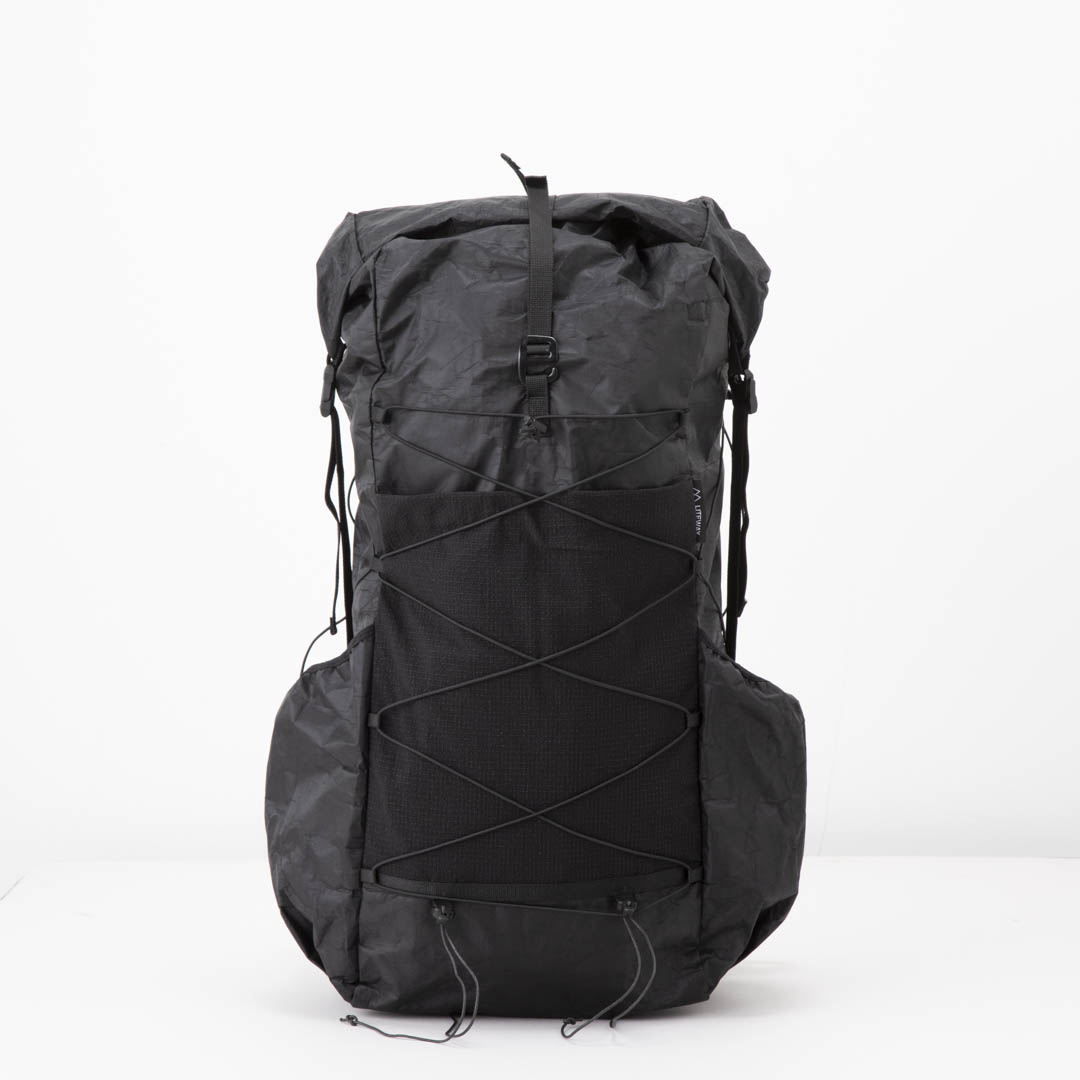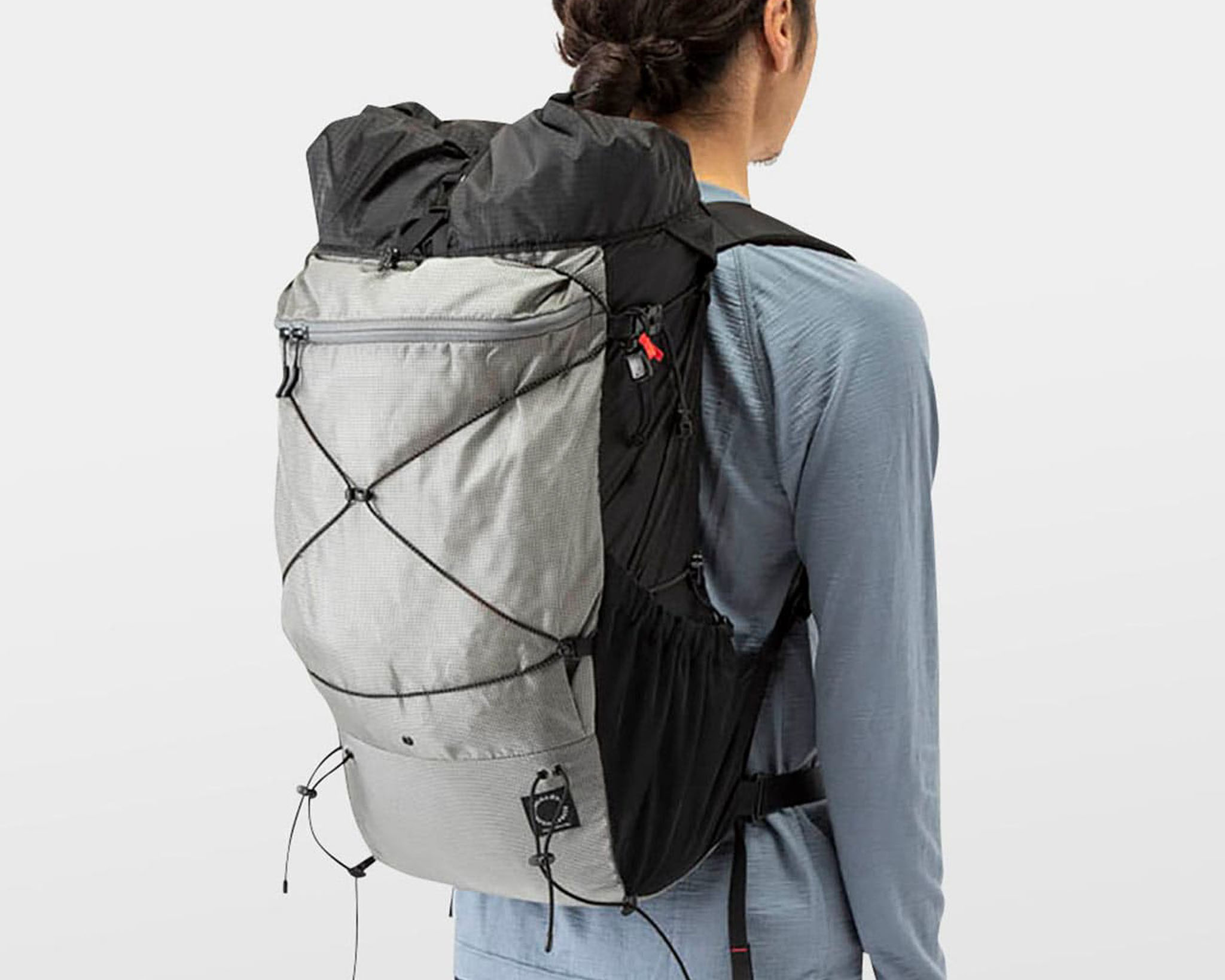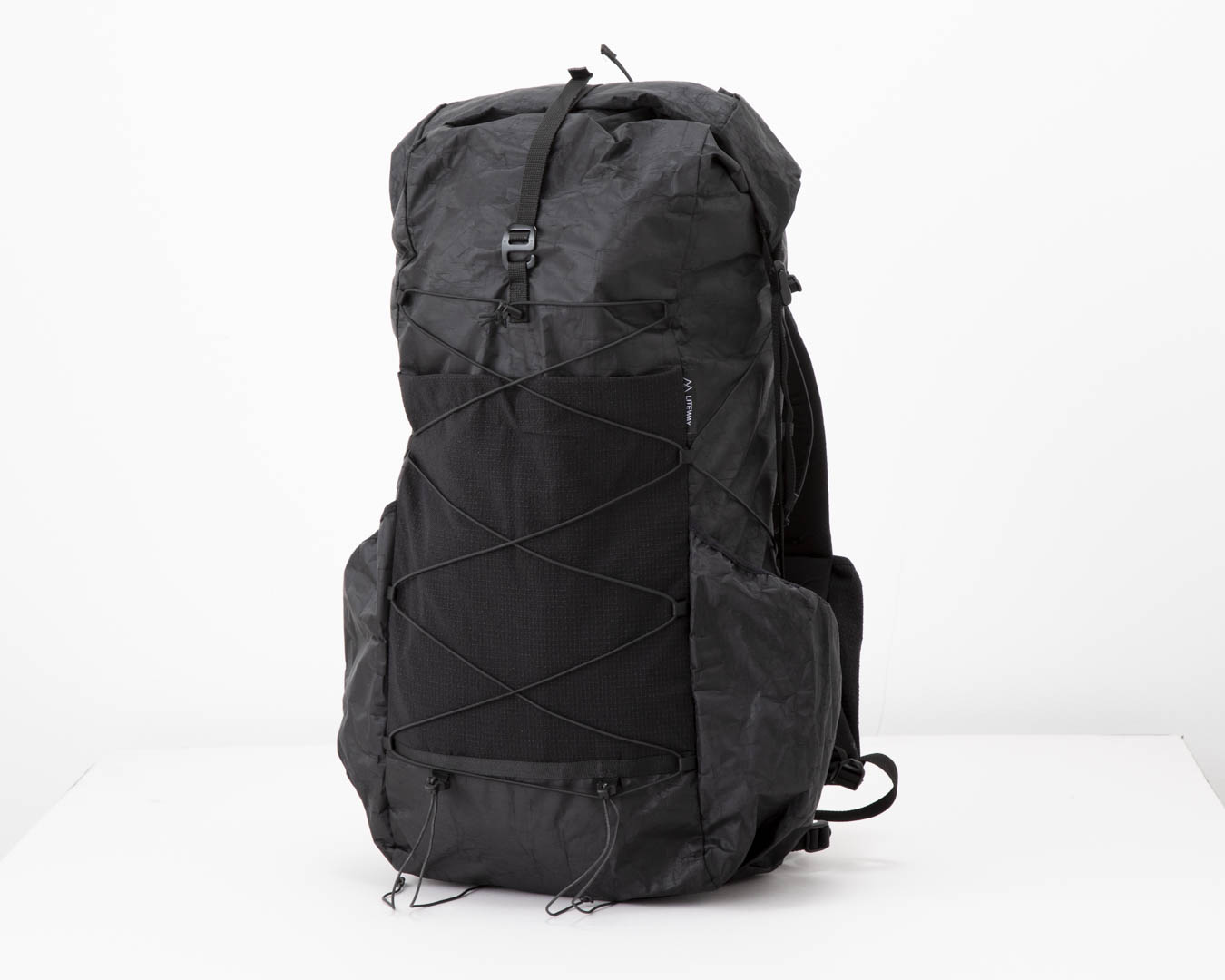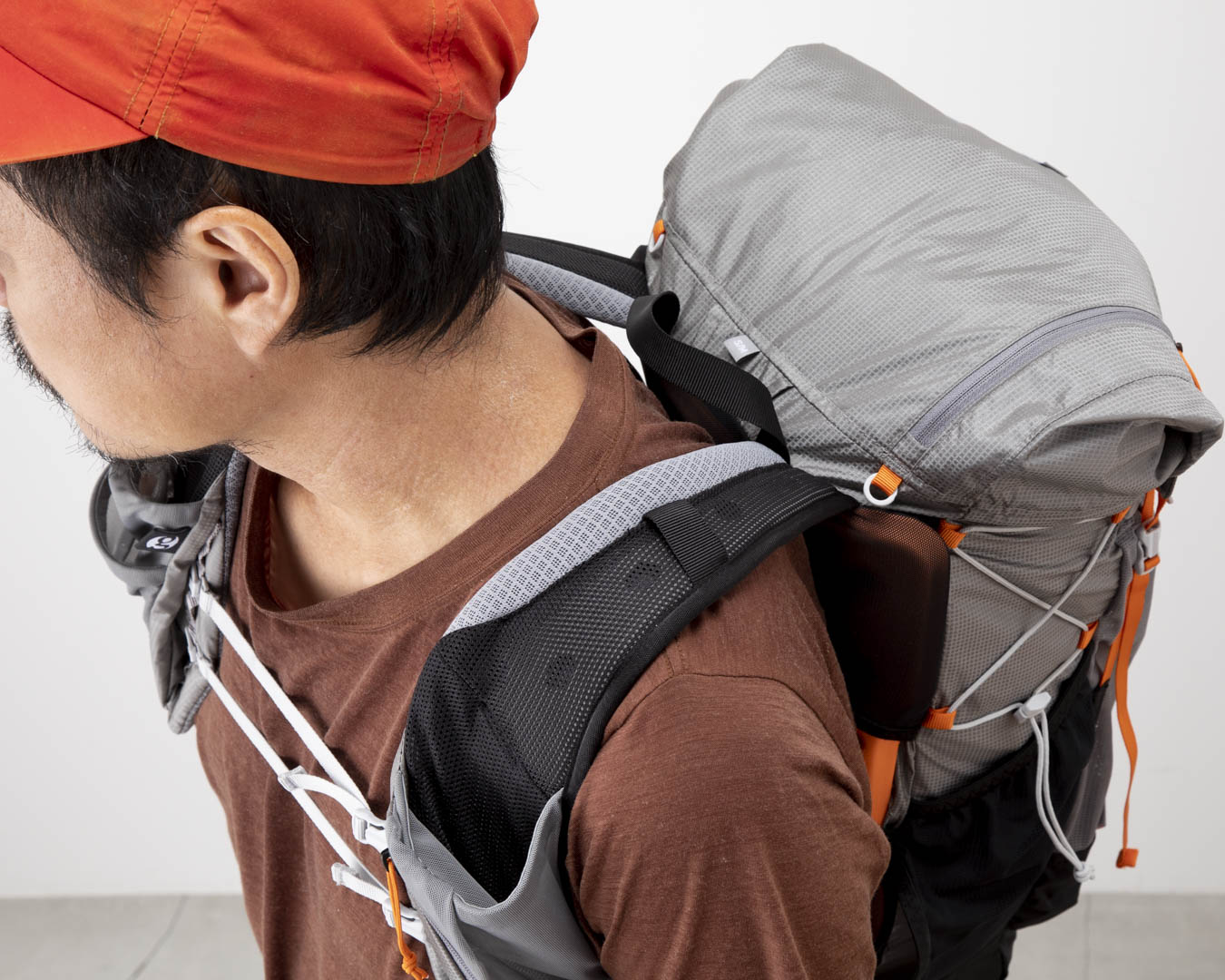10 Modern Ultralight backpacks – Part 1
Photography: Hikaru Otake
10 Modern Ultralight backpacks – Part 1
Photography: Hikaru Otake
In the relentless pursuit of developing cutting-edge outdoor gear, Yamatomichi finds itself constantly engaged in innovation. Along this journey, it’s only natural to seek inspiration by examining products from other companies. Over time, we unwittingly amassed a collection of backpacks from various competitors, primarily hailing from international manufacturers. Such gatherings of ultralight (UL) backpacks are a rare occurrence, and this presented us with a unique opportunity. With a commitment to continuous learning, we decided to conduct a comparative analysis, allowing our team members to shoulder these backpacks under the same conditions, sparking spirited discussions and evaluations.
In the year 2023, as we delve into the trends of ultralight backpacks, we have narrowed down our selection to those weighing less than 1 kilogram. This diverse lineup encompasses everything from FKT-style backpacks, representing the latest trends, to larger models equipped with frames, resulting in a total of 10 distinct options.
While our shoulder-to-shoulder comparison serves as a valuable exercise, it’s important to note that we haven’t subjected these backpacks to extended real-world trail use. Therefore, this assessment alone cannot definitively determine the merit of the featured products. Nonetheless, conducting these tests has provided us with invaluable insights and a firsthand sense of the backpacks’ performance. It’s worth mentioning that the opinions expressed here are those of our staff and do not necessarily reflect the views of Yamatomichi Corporation.
Without further ado, let’s embark on this journey. We’ll present the results of our nearly four-hour-long test in two installments, offering an in-depth look at the state of ultralight backpacks in 2023. What does the future hold for UL backpacks? Let’s find out!
The Backpacks

PA’LANTE Joey

ATELIER LONGUE DISTANCE
Hybride EPL Ultra 200

YAR GEAR 28L Mountain Drifter

LITEWAY Gramless Pack DCF

GOSSAMER GEAR Fast Kumo
The Backpack Testers

Hidenori Maehara: I’m Hidenori Maehara, the manager of Yamatomichi Kamakura. I assist customers in choosing the right backpack for their needs. I have a background as a former physical therapist, which gives me specialized knowledge about the human body. I’ve also thru-hiked New Zealand’s Te Araroa trail. Recently, I’ve been particularly focused on extreme lightweight backpacking. In terms of my physique, I’m 178cm tall and weigh 75kg.
Takahiro Watanabe: I’m Takahiro Watanabe, a researcher at Yamatomichi Laboratory, where I’m involved in product development and research. My passion lies in trail running, whether it’s navigating deserted mountain trails at night or crossing Japan from coast to coast in one go. You could say I’m a bit of an “extreme” enthusiast when it comes to outdoor adventures. Despite my lean frame, I’ve got quite a bit of stamina. I stand at 175cm tall and weigh 65kg.
Masaaki Mita: I’m Masaki Mita, the editor-in-chief of Yamatomichi JOURNALS. With many years of experience as an outdoor writer, I’ve had the opportunity to explore the great outdoors extensively. I even authored ‘THE BACKPACK TEST 2018’ in the past. When it comes to my hiking style, I lean more towards traditional ultralight hiking. Physically, I’m of average build, standing at 175cm tall and weighing 67kg.
The following terms will be used to describe the parts of the backpack.


We start off by trying on our very own MINI
Masaaki: For this evaluation, we want to compare backpacks ranging from 24L to 36L. We’ll load each of them with the same 5kg weight, which is what we usually use for MINI, and 8kg for THREE. Let’s start by putting on the MINI as a baseline for our assessment.

MINI 2023 Gray
Capacity: 30L/32L
Weight: 380g/398g
Main Fabric: 70D HT PC Coated Ripstop Nylon/Black UHPE Fine Grid
Masaaki: ”Tries on the MINI” Well, this feels almost too natural for us. It’s almost to the point where we have no particular comments, to be honest! “Laughs”
Hidenori: ”Tries on the MINI” Indeed, I’ve gotten so used to it that I’m not sure what else to say! It’s become what I consider “the backpack” for me. That been said, the weight distribution, where it rests on the hips while mostly being carried by the upper body and shoulders, still feels great.
Takahiro: ”Tries on the MINI” I have to agree; there’s really nothing to add here! It’s become my standard, and I’ve grown so accustomed to it that I might not even notice any issues that someone else might feel.
Masaaki: You’re absolutely right; as an ultralight backpack carried primarily on the shoulders, the MINI has already become a standard in Japan. Its usability, including the pockets and abundance of bungee cords, is excellent, and it offers great expandability. There’s minimal stress while using it. If I were to nitpick, I’d say having some smaller pockets would be convenient personally. However, considering the MINI has been around for about a decade, I’m curious to see how it stacks up against newer backpacks. Let’s dive right in and find out.

The weights used in the test are what we use for displayed backpacks at our stores. They come in two varieties: one weighing 5kg and another weighing 8kg.
① PA'LANTE - Joey
A staple for modern FKT’ers

Capacity:28L
Weight:395g
Main Fabric:210D HDPE Nylon Rip-stop
Type:Frameless
https://palantepacks.jp/products/joey
Masaaki: Let’s start by taking a look at the Palante Joey. As mentioned in Tetsuya Tsuchiya’s article “The Evolution of UL Hiking,” which is available on Hikers Depot’s website, the latest trend in modern ultralight backpacks is geared towards the style of FKT (Fastest Known Time) hiking. FKT involves covering long distances with minimal gear, walking almost non-stop. Backpacks designed for FKT are becoming smaller in size, with numerous easily accessible pockets for quick access. Palante, founded in 2015, is often seen as a pioneer in this modern FKT backpack style.
Takahiro: Fun fact, Palante’s founder is an FKT hiker.
Hidenori: “tries it on” This feels a bit small for me. Even with all the straps loosened, it’s quite tight “laughs.” But since this backpack only comes in one size, it’s probably supposed to be very snug. With a pack weight of around 6kg, it might be a challenging hike.
Takahiro: “tries it on” It feels like they designed the shoulder straps first and added compartments afterward. Even for me, it seems slightly small. With this weight (just under 6kg), I find it a bit constricting. The difference between having one or two sternum straps might also come into play. With two or three straps, especially when the pack is heavy, it can feel quite constricting.

The sternum strap is fastened with two straps, designed to fit snugly, with minimal slack, even when worn by a model who is 175cm tall and weighs 67kg. The shoulder harness features two pockets, each made of ultra-stretch material. The bottom part of the shoulder strap has a unique design with two extensions from the ring.
Masaaki: This Joey is the smallest model from Palante at 28L, and its shoulder straps are made of 3D mesh, forming a flat base at the attachment point. Is this type of shoulder design common in trail running packs or running vests?
Takahiro: This design is definitely influenced by running.
Hidenori: Palante also offers models with more traditional shoulder strap shapes, right?
Masaaki: The flagship model, V2, has more conventional shoulder straps. The Joey, at 28L, is one of the smaller sizes Palante offers, which explains the influence towards running.
Takahiro: It feels quite snug. There’s no sway, but it’s a bit too restrictive. I feel like it might not work for larger runners in the West. It might be more suitable for pack weights around 3kg, not for carrying 5kg like today.
Masaaki: “tries on” Indeed, even with all the straps fully opened I’m 175cm tall and 67kg, and it feels small. There must be people with broader chests than mine. It can feel constricting when using two sternum straps. Using just the top one might be more natural “removes one strap.” Yeah, this feels more comfortable. But this shoulder structure does seem to provide good support along the shoulders. It doesn’t wobble, and if I were choosing a backpack this size (28L), I might consider this one.

The shoulder strap’s base has a structure reminiscent of trail running packs, with a mesh fabric and core material.
Hidenori: But for this, I’d like to lighten the load even more, maybe under 5kg would be ideal.
Masaaki: The main compartment is small, and there’s limited external attachment space, so you’re naturally inclined to cut down on your gear.
Takahiro: It would be great if the bottom pockets could pass through from both sides. That way, you could sandwich items like the our Minimalist Pad in there.

The bottom pocket has a design that appears to have become the new standard.
Masaaki: But everyone seems to find the bottom pockets convenient, so that’s why they’re so prevalent. I’ve never used them myself, so I can’t say for sure.
Hidenori: It does seem like it’s easier to access items than from side pockets. When it’s on the side, your arm’s range of motion can be restricted, but with the bottom, you can easily reach in.
Takahiro: Indeed, it’s become common for backpacks to have shoulder bottle holders, and people have stopped putting drinks in the side pockets. Having heavier items lower on the sides isn’t ideal for weight distribution.
Hidenori: But I still prefer not to have the weight on my shoulders.
Masaaki: I’m not a fan either.
Takahiro: This mesh is made of Ultrastretch, a robust and stretchy material with Dyneema threads.
Hidenori: This material has become quite popular recently, right? I think Palante played a role in popularizing Ultrastretch. Maybe they added the stretch pockets because of this material.
Masaaki: Naturally, having pockets in this position could lead to quick wear and tear when placed on rocky terrain or similar situations.
Takahiro: This material is tough, so it’s less likely to develop holes.

All pockets on the front, sides, and bottom are constructed solely with ultra-stretch material, and their strength is evident from the fact that they are not reinforced.
Masaaki: While this compact and lightweight bag with a vest-style shoulder strap resembles fastpacking backpacks, FKT backpacks seem to serve a somewhat different purpose, wouldn’t you say?
Takahiro: They’re definitely more robust in construction. In trail running styles, you don’t need materials this durable.
Masaaki: Perhaps they’re intended for longer hikes that span weeks or even months while resupplying along the way. Also, FKT backpacks seem to be more focused on brisk walking rather than running. But overall, not only this Joey but Palante in general is an intriguing brand. You can see the influence they’ve had on other backpacks we’ve gathered today.
Hidenori: I think it’s because gear has become so compact and lightweight that backpacks like this have emerged.
② ATELIER LONGUE DISTANCE - Hybride EPL Ultra 200
French-made UL backpack that combines a backpack and running vest.

Capacity: 25L
Weight: 375g
Main Fabric: Ultra200
Type: Frameless
https://shop.aifa.co.jp/shopdetail/000000000160/
Masaaki: Next up is Atelier Long Distance. It’s a French brand. If you check their official website, they primarily offer custom orders. We don’t have all the details, but it seems like this model is imported by a Japanese distributor who specifies the design based on custom orders. The material used here is the popular Ultra 200, which is lightweight and excels in tear resistance and waterproofing. It’s similar in structure and characteristics to DCF, although it comes with a higher price tag. One unique feature of this backpack is that the shoulder straps are made entirely of thick mesh material and do not have any inner support.
Hidenori: “tries it on” I don’t mind that the shoulder straps don’t have inner support at all. It’s all mesh, so it seems to offer good ventilation. It feels softer than the Palante. Maybe this side structure is working well? Normally, support comes from three points – both shoulders and the waist – distributing the load evenly over the upper body, as if you’re being hugged behind. But it seems like the load carry points are lower, below the shoulder blades, and lower than the MINI. TThe structure supports from below, giving the impression of a lower weight distribution.

Shoulder straps are non-adjustable and made of all-mesh fabric. The straps also wrap around the stomach area with its flat structure with pockets.
Takahiro: That’s what bothered me as well. With this harness, I think you need to make the bottom smaller like the Answer 4 Focusto ensure that the people don’t over pack, making it bottom heavy.
Hidenori: I think so also.
Masaaki: Visually, you look like your carrying the weight at the right position though.
Hidenori: Also, when you put a bottle in the shoulder pocket, it hits your shoulder. I’m not a fan of that.
Takahiro: “Takes it from Takahiro and tries on” Personally, I feel like the shoulder pocket is positioned too low, even for my body type. However, with the current load of just under 6kg, I could probably hike for a long time without any issues. But that side structure of the shoulder straps concerns me a little.
Hidenori: Putting items there might indeed change the load balance.
Takahiro: It might be better if it were even thinner. It has a surprisingly noticeable presence.
Masaaki: “tries it on” Ah, there’s no adjustment for the shoulder straps. I see, this design is fixed. But it doesn’t quite fit my body. I feel like I want to pull the shoulder straps up a bit more.
Takahiro: Yes, I’d like it to be positioned higher.
Hidenori: People might choose this based on whether it fits them since you can’t adjust the size.
Masaaki: However, on the website you can customize your order, so maybe those adjustments can be made when placing an order.

Simple yet beautifuly finished with fine details.
Masaaki: As expected from a French brand, even the small details like the color of the bungee cord and the overall design show great attention to detail. It looks visually impressive. Unfortunately, it didn’t fit my body well.
Hidenori: I was fine with it as long as it was carrying a weight of 5kg.
Takahiro: I also had a more positive impression of this one compared to the Palante.
③ YAR GEAR - 28L Mountain Drifter
A simple modern American UL backpack.

Capacity:28L
Weight:417g (Measured in-house)
Main Fabric:Ultra200
Type:Frameless
https://www.yargear.com/products/28l-mountain-drifter
Masaaki: Next up is the 28L Mountain Drifter by YAR GEAR. This feels like “The Garage Brand of America,” where a former thru-hiker handcrafts the backpack alone. It’s made of Ultra 200, and the design feels like a blend of old-school Ray Way-style UL backpacks with the latest materials, featuring pockets on the shoulder straps and the bottom, reminiscent of the Palante. It’s advertised as 28L, but it seems like it could hold even more.
Takahiro: I stumbled upon this on Garage Grown Gear, and the reviews were exceptionally positive. Some said it’s the “Best Backpack Ever!”
Masaaki: Wow, I wonder what makes it so great? It has the look of a typical UL backpack with no frame or pad on the back. But those side pockets are quite large. The front and bottom pockets are made of Lycra material, so the bottom pocket might especially be prone to tearing.

Front and bottom pockets are made of Lycra material. The hip belt is detachable.
Hidenori: “tries it on” It feels quite familiar to carry. It’s similar to the MINI or MINI2. The load balance also feels close.
Takahiro: “tries it on” You’re right. It feels like the load is on top of the hips, similar to the MINI. Not bad at all.

The shoulder straps have Lycra pockets, but when you put a bottle in them, they may touch your arms. The hip belt is positioned relatively high.
Masaaki: “tries on” It does feel like the MINI, haha! Since there are no pads on the back, it has a softer feel than the MINI. But, like you mentioned, the shoulder pocket hits and rubs against your arm when you put a bottle in there. They might need to rethink this part. Also, the position of the hip belt is a bit too high, even on the 19-inch model with the longer torso. It ends up on the upper abdomen. Since it’s detachable, it will probably be used without it most of the time. Nevertheless, it’s a backpack made with craftsmanship, and I can appreciate that. Even if I happen to use it for some reason, I think I could cherish it and use it with care.
④ LITEWAY - Gramless Pack DCF
Originating from Ukraine. A modern UL backpack with contemporary details.

Capacity: 35L
Weight: 390g
Main Fabric: DCF
Type: Frameless
https://liteway.equipment/packs/gramless-dcf
Masaaki: Next up is the LightWay Gramless Pack DCF, from a Ukrane. For those in Ukrane, we pray for y’all for the war to end. This one is made of DCF material, but it appears they’ve transitioned to the successor Ultra 200 material now. It’s interesting to see how the popularity of DCF has shifted to eco-friendly Ultra 200 material in backpack construction in recent years. However, this pack is sized for heights between 150cm and 175cm, so it might be a bit small for you, Hidenori-san, at 178cm.
Hidenori: The padding on this feels soft. Also, they’ve used Lycra on the back mesh, which is quite intricate. “Tries on” Hmm, what is it… It feels like the shoulder straps are too close to the sides of my body. When I try to distribute the load to my shoulders, it feels like it’s pushing into my hips instead of fitting my upper body. Let me try adding the hip belt. It’s an unusual design with two attachment points, but it might be because of the small size; it’s sitting on my abdomen rather than my hips. Looking at it this way, YAR GEAR might have had a really good balance. Could you try it on for a moment?

The hip belt has a unique shape with two separate base sections and is removable.
Takahiro: “tries it on” I don’t feel the load shifting onto my hips, but the shoulder straps are quite narrow.
Masaaki: Measuring it, the shoulder strap width is 6cm. For comparison, the MINI from Yamatomichi is 7cm. However, this pack is the “S/M” size, so if it were “M/L,” the width might be wider. “tries on” Indeed, if I were to wear this for an extended period, my shoulders might hurt. I’m 175cm tall, and maybe it’s because the size is small. Also, the hip belt doesn’t sit on my hips; it comes up to my abdomen. In this case, I might not need the hip belt at all.

The shoulder straps are on the softer side and feature an intricate design with Lycra overlay on top of a mesh lining. There is a pocket made from the same ultramesh material as the front pocket, but it tends to interfere with the arm when a bottle is placed inside. There are no pads or frames on the back.
Takahiro: It feels like the pack is moving away from your back, and there’s a lack of unity. It doesn’t conform well to the load, and it ends up having an odd shape.
Hidenori: The pack seems to bend and create a zigzag shape in the middle, doesn’t it? Even though the MINI, even in a slightly smaller M size, doesn’t feel uncomfortable for me.
Masaaki: It could be due to the size, but I couldn’t quite give it a proper evaluation. If there’s an opportunity, I’d like to try the M/L size.
⑤ Gossamer Gear - Fast Kumo
The Kumo reborn as an FKT backpack.

Capacity: 36L
Weight: 470g
Main Fabric: 70D Robic Ripstop Nylon
Type: Frameless
https://shop.aifa.co.jp/shopdetail/000000000165/
Masaaki: Next up is the Fast Kumo, a modified version of the Gossamer Gear Kumo by an American UL brand, Gossamer Gear, known for being a pioneer in the field. It features vest-type shoulder straps and a shorter back length compared to the original Kumo.
Hidenori: “tries on” These shoulder straps feel incredibly comfortable, even without the hip belt. The back length is shorter, so the hip belt sits on my ribs. Since it’s removable, I think I’d prefer not to use it. Oh, you can adjust the hip belt’s position downward. (After adjusting it) Yes, now it’s on top of my hip bones. With this, it might be better to keep it. Anyway, the shoulder straps are excellent. There’s absolutely no sway.

The vest-style shoulder straps feature complex pocket structures. These pockets didn’t interfere with the arms even when a bottle was placed inside. The hip belt, which can be adjusted in position, also comes with pockets.
Takahiro: “tries it on” It feels really comfortable, with no discomfort anywhere. There’s no strange weight distribution, and it doesn’t feel like it’s primarily top-heavy or bottom-heavy; it’s supported evenly.
Masaaki: It also has two pockets on each shoulder strap, a well-thought-out design.
Takahiro: Design-wise, it may look somewhat elaborate, but it’s well thought out and has a refined feel. Plus, the craftsmanship on the shoulder straps is impressive. They have thick padding, cutouts, and mesh, making them a challenge to sew.

The shoulder straps combine mesh, padding, and core materials in a complex manner. Their shape and thickness leave a very favorable impression.
Masaaki: “tries on” Indeed, the shape of the shoulder straps is excellent. They form an S-shape and gradually widen from the attachment point, which seems to hug the shoulders better. Even when the shoulder straps are loosened, the fit remains excellent. Both the shape and thickness are great.
Takahiro: Looking at it from behind, it doesn’t seem like there’s much upper load, but it feels like it’s dropping down.

The backpack is not positioned too high, but it feels like it fits in a very comfortable location. On the back, there are removable dedicated pads, a common detail of Gossamer Gear products. The mesh side pockets are designed for easy access from the sides.
Masaaki: Still, the load is being distributed to the right places. However, concerning the back length, I’m used to the wearing comfort of packs like the MINI, so a bit more length might be better. Interestingly, I actually prefer the slightly longer back length of the regular Kumo. Gossamer Gear doesn’t give me the impression of a brand that ventures into new things with an arbitrary approach, but it seems they’re evolving properly. When we look at the details, it’s like there’s no trace of the garage brand feel anymore. It’s more like a high-quality manufacturer’s product.
Takahiro: It’s well-crafted, indeed.
Masaaki: It exudes a sense of quality a step above younger brands. It’s a bit heavier at 470g, but it’s impressive.
Takahiro: For me, if they added 100g more to the total weight of the pack and the fit still remained this good, I wouldn’t mind.
Masaaki: It has a classical look combined with the latest in wearing comfort. However, if they’ve come this far, they could have even changed the bag’s design from the Kumo, but it’s still a high-quality product with a lot of ambition.

JOURNAL Editor-in-Chief / Photographer
Working as a photographer for cultural and music magazines, a deep passion for adventures emerged. Drawn to the grandeur of nature during adventures to many countries, Masaaki began hiking as a way to connect with nature. Before long he was working for outdoor magazines, with writing assignments, leading to the current state of not knowing his main profession. As a writer he, continues to pursue ultralight hiking and the culture of Japanese independent makers as a lifelong passion. Through a work-related interview with Yamatomichi’s founder Akira Natsume, he gradually found himself in his current positions through sharing drinks and going on hiking adventures with Akira.



















